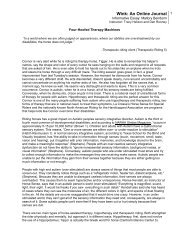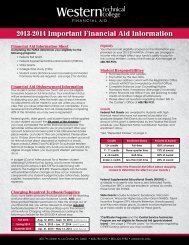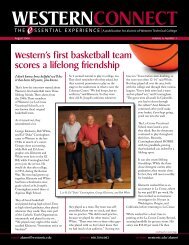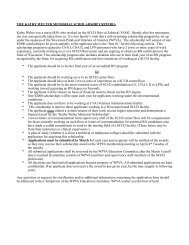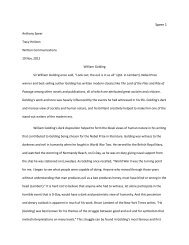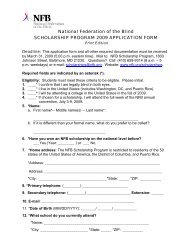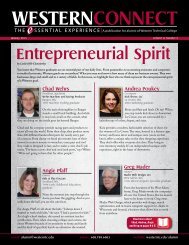The History of Western Technical College
The History of Western Technical College
The History of Western Technical College
You also want an ePaper? Increase the reach of your titles
YUMPU automatically turns print PDFs into web optimized ePapers that Google loves.
as the most outstanding here. In addition, her award also brought the homemaking department an electric mixer, and<br />
her instructor, Mrs. Kathryn Schomberg, received a transistor radio.<br />
Effective with school year 1960-61, a $2.00 registration fee was affixed for day school students who are not compelled by<br />
law to attend the day classes.<br />
In November 1960, an apprenticeship conference was held that stressed the importance <strong>of</strong> apprenticeship. <strong>The</strong><br />
conference drew 125 persons from seven counties.<br />
1960 Auditorium events included . . .<br />
February 8 <strong>The</strong> La Crosse Symphony Orchestra presented a concert that featured Christian Ferras, a violinist.<br />
<strong>The</strong> concert was under the direction <strong>of</strong> Peter J. Michelsen.<br />
April 4 Lee Luvisi was guest artist with the La Crosse Symphony Orchestra. Peter J. Michelsen was the<br />
conductor.<br />
November 7 David Abel, a renowned violinist, was guest artist with the La Crosse Symphony Orchestra.<br />
Peter J. Michelsen was the conductor.<br />
December 4 La Crosse’s traditional Christmas holiday musical event, “<strong>The</strong> Messiah,” was presented. <strong>The</strong><br />
oratorio <strong>of</strong> G. F. Handel was under the direction <strong>of</strong> Elvin Saterbak, and had more than 100 singers,<br />
piano and organ accompaniment. Since 1958, the Vocational Choir and the State <strong>College</strong> group<br />
together sang “<strong>The</strong> Messiah.” <strong>The</strong> college choir had 70 voices in its group.<br />
In September 1961, at an apprenticeship meeting <strong>of</strong> 35 master barbers, including shop owners and one apprentice from<br />
the nine-county La Crosse area, it was announced by a Wisconsin State Board <strong>of</strong> Health Official that after October 1,<br />
barber school graduates from Illinois “will not be recognized for employment in Wisconsin.” <strong>The</strong> reason for the action<br />
was the “decreased quality <strong>of</strong> practice and theory <strong>of</strong> Illinois barber training.” <strong>The</strong>re were 27 barber schools in Illinois,<br />
compared with 10 a few years ago, which have been “flooding” Wisconsin with apprentices while Wisconsin men found it<br />
hard to get jobs.<br />
“Fallout” . . . “radioactive fallout” – <strong>The</strong>se were words much in the news in 1961. A model fallout shelter, built by the<br />
Vocational shop class, was on display for six months in the basement <strong>of</strong> the Vocational School for the public to view. It<br />
was the first model shelter completed in Wisconsin and one <strong>of</strong> the first in the nation. <strong>The</strong> shelter had everything needed:<br />
food, cooking utensils, sanitation supplies, bedding and first aid supplies in case one needed to live in the shelter for<br />
several weeks.<br />
Unemployment in the community was becoming evident. Enrollment at the Vocational School began to increase. In<br />
normal times, when most people are employed, vocational and adult school enrollment remains quite stable – but during<br />
periods <strong>of</strong> unemployment and depression in industry, increased enrollments soon result in all departments <strong>of</strong> the school.<br />
In January 1961, the lay<strong>of</strong>fs in neighboring cities resulted in La Crosse residents returning to the city from employment in<br />
out-<strong>of</strong>-town industries. “Evening school enrollment has been gratifying,” said Coleman, “the trades classes have all been<br />
filled and there are large waiting lists . . . most homemaking classes have openings and there are a few in business<br />
education.”<br />
1961 saw an addition to the Coleman facilities at the corner <strong>of</strong> Seventh and Vine Streets. Several new programs were <strong>of</strong>fered<br />
that year, including Auto Body and Electronics. Hackner, Schroeder and Associates were the architects for $470,000<br />
construction project.<br />
1961 Auditorium events included . . .<br />
February 6 <strong>The</strong> La Crosse Symphony Orchestra, directed by Peter J. Michelsen, and the La Crosse Vocational<br />
Civic Choir, directed by David Mewaldt, presented a joint concert. Guest artist was Lorin<br />
Hollander, a pianist. Hollander was a guest with the Detroit Symphony in New York, as well and as<br />
a guest on the Perry Como, Ed Sullivan and other television shows.<br />
March 21 <strong>The</strong> La Crosse Vocational School Civic Choir presented its annual concert. <strong>The</strong> opening section <strong>of</strong><br />
the program was Gabriel Faure’s “Requiem.” Faure is noted for his beautiful melodies and “it was<br />
clearly evident in this great and solemn work . . . It is a credit to the group and the conductor that<br />
the choir was able to perform the music with the ability that it displayed.” Elvin Saterbak was the<br />
director.<br />
April 10 <strong>The</strong> La Crosse Symphony Orchestra, under the direction <strong>of</strong> Peter J. Michelsen, presented its spring<br />
concert. Lucille Kailer, who studied at the Wisconsin Conservatory <strong>of</strong> Music after graduation from<br />
Marquette University, was guest soloist.





